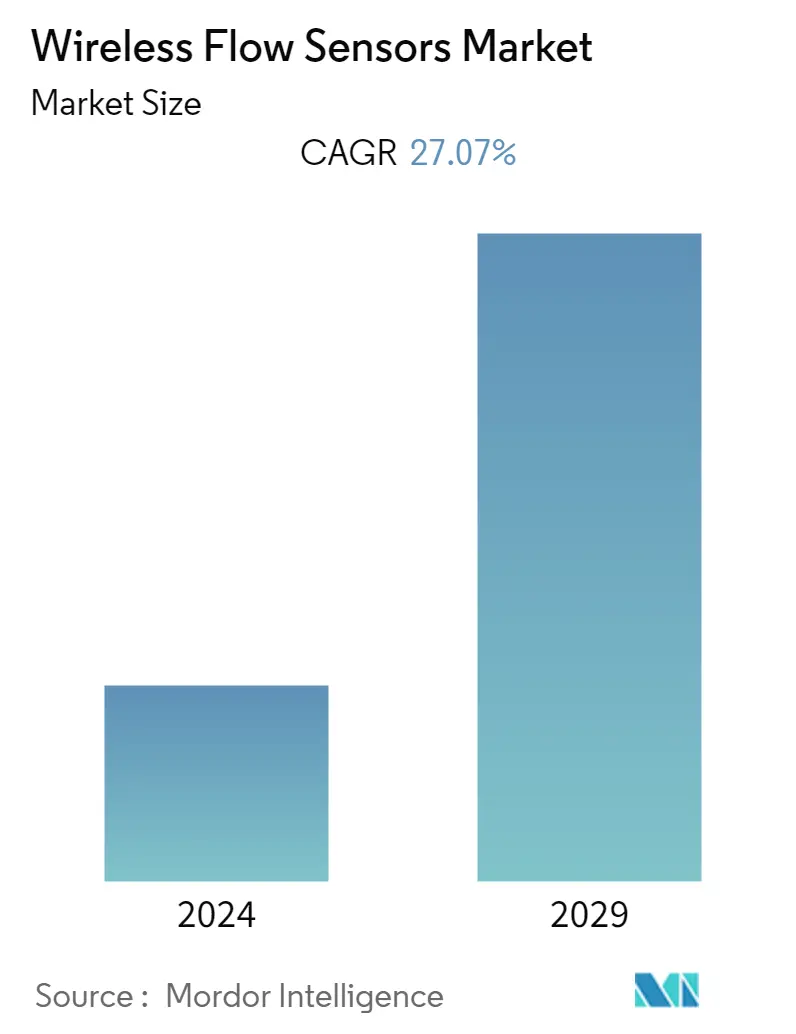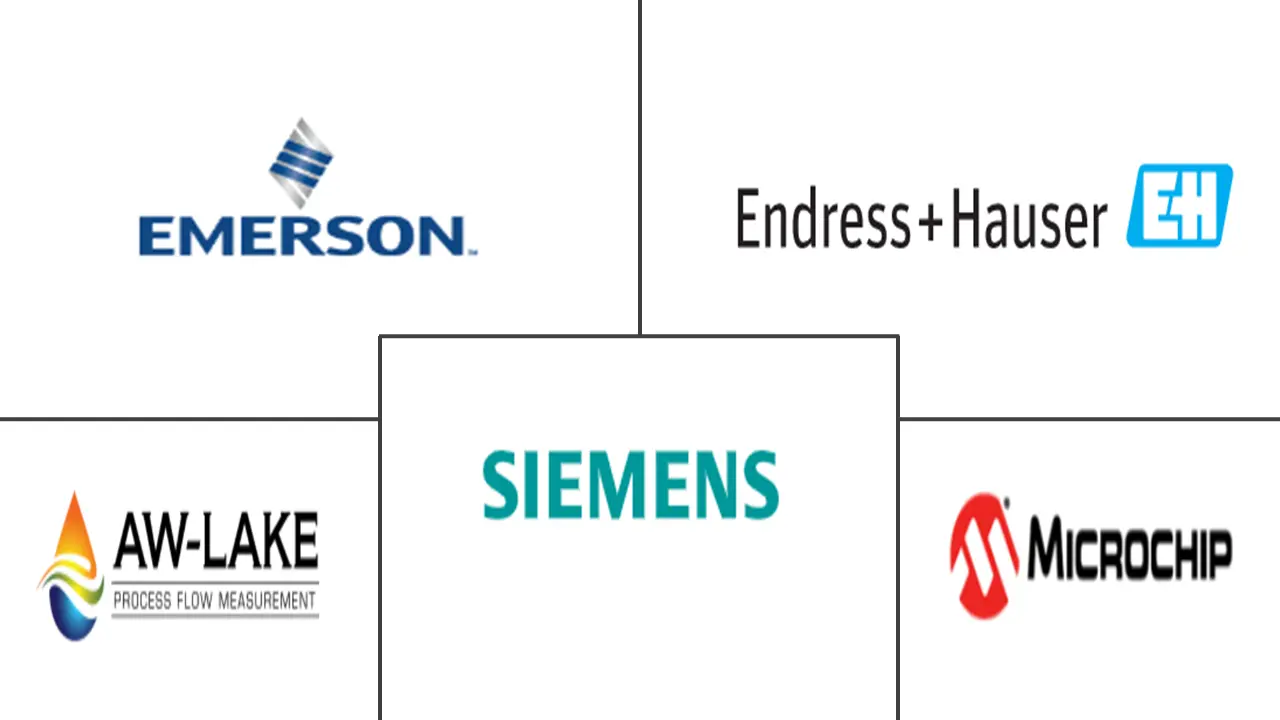Market Size of Wireless Flow Sensors Industry

| Study Period | 2019 - 2029 |
| Base Year For Estimation | 2023 |
| CAGR | 27.07 % |
| Fastest Growing Market | Asia Pacific |
| Largest Market | North America |
| Market Concentration | Low |
Major Players
*Disclaimer: Major Players sorted in no particular order |
Wireless Flow Sensors Market Analysis
The wireless flow sensors market is expected to register a CAGR of 27.07% over the forecast period. With a lot of innovation and modern technologies such as Coriolis, ultrasonic, magnetic, and vortex flow sensors are a significant competition to traditional measurement technologies. These advanced technologies have also witnessed competition among themselves. Each technique has pros and cons that suit a specific application.
- The revival of the oil and gas industry and the expanding infrastructure in the water and wastewater industry are likely to drive growth in the medium to long term. Growth opportunities are opening in developing economies, such as China and India, that have developed their oil, gas, and chemical industries.
- The increasing quest for new energy sources, renewable energy development, government regulations, and rapid technological advancements are the key drivers making the wireless flow sensors market grow with a boom. The demand for wireless flow sensors is increasing significantly as it saves time, materials, and labor. With modern microelectronics, flowmeters offer many communication options.
- Flow sensors can detect leaks, blockages, pipe bursts, and changes in liquid concentration due to contamination or pollution. Ultrasonic flow sensors are the most popular type of non-contact flow sensor. Ultrasonic flow sensors send high-frequency sound pulses across the flowing liquid or gas medium. These sensors measure the time between the emission of the sound and its contact with the sensor's receiver to determine the flow rate of the gas or liquid.
- Increasing advancements, such as incorporating new protocols to ease the connection to enterprise networks, are further boosting market growth. For instance, a flow sensor can have an Open Platform Communication - Unified Architecture (OPC-UA) server application package built into the flowmeter, allowing the device to communicate with an OPC-UA client and be integrated into Industrial Internet of Things (IIoT) applications. This is accomplished through networking the flowmeter via either LAN or WLAN, which allows the DCS or PLC to be dedicated to the control function. In contrast, this additional communication path can be devoted to diagnostic, monitoring, and reporting purposes.
- The COVID-19 pandemic positively impacted the wireless flow sensors market. According to the World Health Organization (WHO), the water supply had to be kept safe, owing to the chances of virus transmission that could quickly grow through sewage. This factor drove the adoption of biological wastewater treatment systems and propelled the growth of the wireless flow sensors market during the pandemic. Government bodies and non-profit organizations created awareness about water safety and security during the pandemic.
Wireless Flow Sensors Industry Segmentation
Wireless flow sensor comprises the flow sensor, RF transmitter, and RF receiver. These days, installation doesn't require expensive drilling, trenching, or digging, to install power or input/output wiring. Active and passive safety sensors witnessed significant growth due to the automotive sector's need for accident mitigation systems. The emission of hazardous gases led to rules and regulations for emission control and resulted in monitoring the concentration of exhaust gases.
The wireless flow sensors market is segmented by Technology (Bluetooth, ZigBee, RFID, Wi-Fi, WLAN, EnOcean), Application (Water and Wastewater, Chemicals and Petrochemicals, Power Generation, Other Applications), and Geography (North America, Europe, Asia-Pacific, Latin America, Middle East and Africa). The market sizes and forecasts are provided in terms of value in USD billion for all the above segments.
| By Technology | |
| Bluetooth | |
| ZigBee | |
| RFID | |
| Wi-Fi | |
| WLAN | |
| EnOcean |
| By Application | |
| Water and Wastewater | |
| Chemicals and Petrochemicals | |
| Power Generation | |
| Other Applications |
| By Geography | |
| North America | |
| Europe | |
| Asia-Pacific | |
| Latin America | |
| Middle East and Africa |
Wireless Flow Sensors Market Size Summary
The wireless flow sensors market is experiencing significant growth, driven by advancements in technologies such as Coriolis, ultrasonic, magnetic, and vortex flow sensors, which are competing with traditional measurement methods. These modern technologies offer various advantages and are increasingly being adopted across different applications. The market is further propelled by the revival of the oil and gas industry and the expansion of infrastructure in the water and wastewater sectors, particularly in developing economies like China and India. The demand for wireless flow sensors is rising due to their ability to save time, materials, and labor, alongside their enhanced communication options enabled by modern microelectronics. These sensors play a crucial role in detecting leaks, blockages, and changes in liquid concentration, with ultrasonic flow sensors being particularly popular for non-contact measurements. The integration of new protocols for easier connectivity to enterprise networks, such as OPC-UA, is also contributing to market growth, facilitating the incorporation of these sensors into Industrial Internet of Things (IIoT) applications.
The market landscape is highly competitive, with major players like Panasonic Corporation, Honeywell International Inc., and Siemens AG actively expanding their market share through partnerships and product innovations. The United States stands out as a significant consumer of wireless flow sensors, driven by technological advancements and a strong preference for reliable performance in the water and wastewater industry. The North American region benefits from substantial investments and legislative support for wireless technology, further boosting market demand. The COVID-19 pandemic positively impacted the market by increasing the adoption of biological wastewater treatment systems, highlighting the importance of water safety. Despite challenges such as limited awareness and capital in developing markets, the growing adoption of Wi-Fi and WLAN technologies is driving the market forward. Companies are also focusing on reducing industrial waste by converting plastic waste into clean fuels, which is increasing the demand for flow meters in waste conversion processes.
Wireless Flow Sensors Market Size - Table of Contents
-
1. MARKET INSIGHTS
-
1.1 Market Overview
-
1.2 Industry Attractiveness - Porter's Five Forces Analysis
-
1.2.1 Bargaining Power of Suppliers
-
1.2.2 Bargaining Power of Consumers
-
1.2.3 Threat of New Entrants
-
1.2.4 Threat of Substitute Products
-
1.2.5 Intensity of Competitive Rivalry
-
-
1.3 Impact of COVID-19 on the Market
-
-
2. MARKET SEGMENTATION
-
2.1 By Technology
-
2.1.1 Bluetooth
-
2.1.2 ZigBee
-
2.1.3 RFID
-
2.1.4 Wi-Fi
-
2.1.5 WLAN
-
2.1.6 EnOcean
-
-
2.2 By Application
-
2.2.1 Water and Wastewater
-
2.2.2 Chemicals and Petrochemicals
-
2.2.3 Power Generation
-
2.2.4 Other Applications
-
-
2.3 By Geography
-
2.3.1 North America
-
2.3.2 Europe
-
2.3.3 Asia-Pacific
-
2.3.4 Latin America
-
2.3.5 Middle East and Africa
-
-
Wireless Flow Sensors Market Size FAQs
What is the current Wireless Flow Sensors Market size?
The Wireless Flow Sensors Market is projected to register a CAGR of 27.07% during the forecast period (2024-2029)
Who are the key players in Wireless Flow Sensors Market?
Emerson Electric Co., Endress+Hauser Group Services AG, AW-Lake, Siemens AG and Microchip Technology Inc. are the major companies operating in the Wireless Flow Sensors Market.

